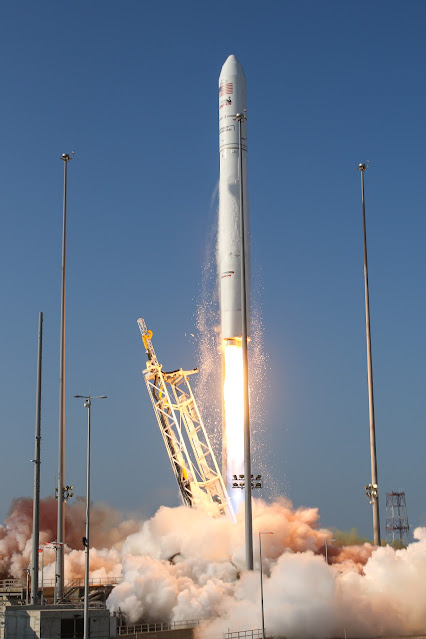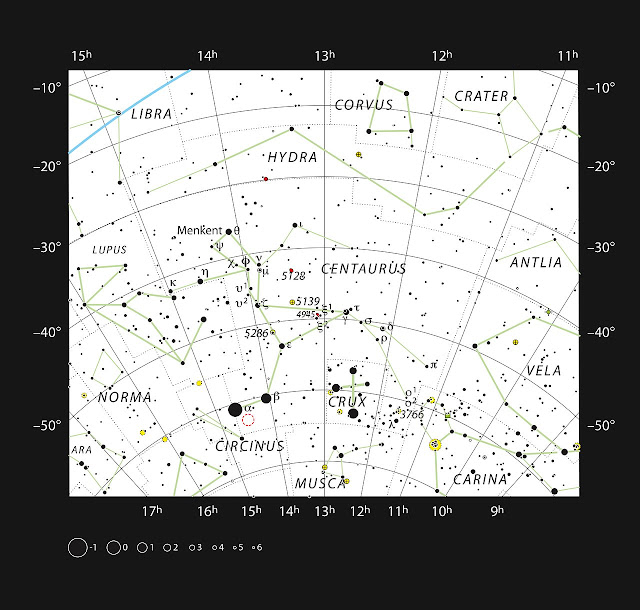ESO - European Southern Observatory logo.
Feb 10, 2022
Artist’s impression of Proxima d (close-up)
A team of astronomers using the European Southern Observatory’s Very Large Telescope (ESO’s VLT) in Chile have found evidence of another planet orbiting Proxima Centauri, the closest star to our Solar System. This candidate planet is the third detected in the system and the lightest yet discovered orbiting this star. At just a quarter of Earth’s mass, the planet is also one of the lightest exoplanets ever found.
“The discovery shows that our closest stellar neighbour seems to be packed with interesting new worlds, within reach of further study and future exploration,” explains João Faria, a researcher at the Instituto de Astrofísica e Ciências do Espaço, Portugal and lead author of the study published today in Astronomy & Astrophysics. Proxima Centauri is the closest star to the Sun, lying just over four light-years away.
Artist’s impression of Proxima d (wider view)
The newly discovered planet, named Proxima d, orbits Proxima Centauri at a distance of about four million kilometres, less than a tenth of Mercury’s distance from the Sun. It orbits between the star and the habitable zone — the area around a star where liquid water can exist at the surface of a planet — and takes just five days to complete one orbit around Proxima Centauri.
The star is already known to host two other planets: Proxima b, a planet with a mass comparable to that of Earth that orbits the star every 11 days and is within the habitable zone, and candidate Proxima c, which is on a longer five-year orbit around the star.
Proxima Centauri in the southern constellation of Centaurus
Proxima b was discovered a few years ago using the HARPS instrument on ESO’s 3.6-metre telescope. The discovery was confirmed in 2020 when scientists observed the Proxima system with a new instrument on ESO’s VLT that had greater precision, the Echelle SPectrograph for Rocky Exoplanets and Stable Spectroscopic Observations (ESPRESSO). It was during these more recent VLT observations that astronomers spotted the first hints of a signal corresponding to an object with a five-day orbit. As the signal was so weak, the team had to conduct follow-up observations with ESPRESSO to confirm that it was due to a planet, and not simply a result of changes in the star itself.
“After obtaining new observations, we were able to confirm this signal as a new planet candidate,” Faria says. “I was excited by the challenge of detecting such a small signal and, by doing so, discovering an exoplanet so close to Earth.”
At just a quarter of the mass of Earth, Proxima d is the lightest exoplanet ever measured using the radial velocity technique, surpassing a planet recently discovered in the L 98-59 planetary system. The technique works by picking up tiny wobbles in the motion of a star created by an orbiting planet’s gravitational pull. The effect of Proxima d’s gravity is so small that it only causes Proxima Centauri to move back and forth at around 40 centimetres per second (1.44 kilometres per hour).

The sky around Alpha Centauri and Proxima Centauri (annotated)
“This achievement is extremely important,” says Pedro Figueira, ESPRESSO instrument scientist at ESO in Chile. “It shows that the radial velocity technique has the potential to unveil a population of light planets, like our own, that are expected to be the most abundant in our galaxy and that can potentially host life as we know it.”
“This result clearly shows what ESPRESSO is capable of and makes me wonder about what it will be able to find in the future,” Faria adds.
ESPRESSO’s search for other worlds will be complemented by ESO’s Extremely Large Telescope (ELT), currently under construction in the Atacama Desert, which will be crucial to discovering and studying many more planets around nearby stars.
Ultralight Planet Found Next Door (ESOcast 250 Light)
Video Credits: ESO
Directed by: Herbert Zodet and Martin Wallner.
Editing: Herbert Zodet.
Web and technical support: Gurvan Bazin and Raquel Yumi Shida.
Written by: Anita Chandran and Juliet Hannay.
Music: Stellardrone — The Divine Cosmos.
Footage and photos: ESO, L. Calçada, Nick Risinger (skysurvey.org), F. Char and C. Malin (christophmalin.com).
Scientific consultants: Paola Amico and Mariya Lyubenova.
More information:
This research was presented in the paper “A candidate short-period sub-Earth orbiting Proxima Centauri” (doi:https://www.aanda.org/10.1051/0004-6361/202142337) to appear in Astronomy & Astrophysics.
The team is composed of J. P. Faria (Instituto de Astrofísica e Ciências do Espaço, Universidade do Porto, Portugal [IA/UPorto], Centro de Astrofísica da Universidade do Porto, Portugal [CAUP] and Departamento de Física e Astronomia, Faculdade de Ciências, Universidade do Porto, Portugal [FCUP]), A. Suárez Mascareño (Instituto de Astrofísica de Canarias, Tenerife, Spain [IAC], Departamento de Astrofísica, Universidad de La Laguna, Tenerife, Spain [IAC-ULL]), P. Figueira (European Southern Observatory, Santiago, Chile [ESO-Chile], IA-Porto), A. M. Silva (IA-Porto, FCUP) M. Damasso (Osservatorio Astrofisico di Torino, Italy [INAF-Turin]), O. Demangeon (IA-Porto, FCUP), F. Pepe (Département d’astronomie de l’Université de Genève, Switzerland [UNIGE]), N. C. Santos (IA-Porto, FCUP), R. Rebolo (Consejo Superior de Investigaciones Científicas, Madrid, Spain [CSIC], IAC-ULL, IAC), S. Cristiani (INAF - Osservatorio Astronomico di Trieste, Italy [OATS]), V. Adibekyan (IA-Porto), Y. Alibert (Physics Institute of University of Bern, Switzerland), R. Allart (Department of Physics, and Institute for Research on Exoplanets, Université de Montréal,Canada, UNIGE), S. C. C. Barros (IA-Porto, FCUP), A. Cabral (Instituto de Astrofísica e Ciências do Espaço, Faculdade de Ciências da Universidade de Lisboa, Portugal [IA-Lisboa], Faculdade de Ciências da Universidade de Lisboa, Portugal [FCUL]), V. D’Odorico (OATS, Institute for Fundamental Physics of the Universe, Trieste, Italy [IFPU], Scuola Normale Superiore, Pisa, Italy) P. Di Marcantonio (OATS), X. Dumusque (UNIGE), D. Ehrenreich (UNIGE), J. I. González Hernández (IAC-ULL, IAC), N. Hara (UNIGE), J. Lillo-Box (Centro de Astrobiología (CAB, CSIC-INTA), Depto. de Astrofísica, Madrid, Spain), G. Lo Curto (European Southern Observatory, Garching bei München, Germany [ESO], ESO-Chile) C. Lovis (UNIGE), C. J. A. P. Martins (IA-Porto, Centro de Astrofísica da Universidade do Porto, Portugal), D. Mégevand (UNIGE), A. Mehner (ESO-Chile), G. Micela (INAF - Osservatorio Astronomico di Palermo, Italy), P. Molaro (OATS), IFPU), N. J. Nunes (IA-Lisboa), E. Pallé (IAC, IAC-ULL), E. Poretti (INAF - Osservatorio Astronomico di Brera, Merate, Italy ), S. G. Sousa (IA-Porto, FCUP), A. Sozzetti (INAF-Turin), H. Tabernero (Centro de Astrobiología, Madrid, Spain [CSIC-INTA]), S. Udry (UNIGE), and M. R. Zapatero Osorio (CSIC-INTA).
The European Southern Observatory (ESO) enables scientists worldwide to discover the secrets of the Universe for the benefit of all. We design, build and operate world-class observatories on the ground — which astronomers use to tackle exciting questions and spread the fascination of astronomy — and promote international collaboration in astronomy. Established as an intergovernmental organisation in 1962, today ESO is supported by 16 Member States (Austria, Belgium, the Czech Republic, Denmark, France, Finland, Germany, Ireland, Italy, the Netherlands, Poland, Portugal, Spain, Sweden, Switzerland and the United Kingdom), along with the host state of Chile and with Australia as a Strategic Partner. ESO’s headquarters and its visitor centre and planetarium, the ESO Supernova, are located close to Munich in Germany, while the Chilean Atacama Desert, a marvellous place with unique conditions to observe the sky, hosts our telescopes. ESO operates three observing sites: La Silla, Paranal and Chajnantor. At Paranal, ESO operates the Very Large Telescope and its Very Large Telescope Interferometer, as well as two survey telescopes, VISTA working in the infrared and the visible-light VLT Survey Telescope. Also at Paranal ESO will host and operate the Cherenkov Telescope Array South, the world’s largest and most sensitive gamma-ray observatory. Together with international partners, ESO operates APEX and ALMA on Chajnantor, two facilities that observe the skies in the millimetre and submillimetre range. At Cerro Armazones, near Paranal, we are building “the world’s biggest eye on the sky” — ESO’s Extremely Large Telescope. From our offices in Santiago, Chile we support our operations in the country and engage with Chilean partners and society.
Links:
Research paper: https://www.eso.org/public/archives/releases/sciencepapers/eso2202/eso2202a.pdf
Photos of the VLT: http://www.eso.org/public/images/archive/category/paranal/
Find out more about ESO's Extremely Large Telescope: https://elt.eso.org/
For journalists: subscribe to receive our releases under embargo in your language: https://www.eso.org/public/outreach/pressmedia/#epodpress_form
For scientists: got a story? Pitch your research: http://www.eso.org/sci/publications/announcements/sciann17463.html
Images, Video (mentioned), Text, Credits: ESO/Bárbara Ferreira/Département d’astronomie de l’Université de Genève/Baptiste Lavie/Instituto de Astrofísica de Canarias/Alejandro Suárez Mascareño/INAF – Osservatorio Astrofisico di Torino/Mario Damasso/Instituto de Astrofisica e Ciências do Espaço, Faculdade de Ciências, Universidade do Porto/Nuno Santos/João Faria/ESO and Instituto de Astrofísica e Ciências do Espaço/Pedro Figueira.
Best regards, Orbiter.ch

















































